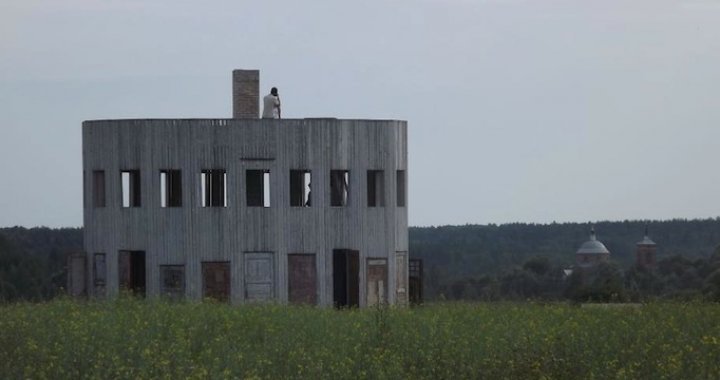
Heterotopia in polemics with utopia
27/08/2012
Held for the seventh year running in the picturesque village of Nikola-Lenivets on the Ugra River, the ArchStoyanie summer festival attracts both numerous enthusiasts of contemporary art and people who simply feel like taking a trip to the outdoors. The scope of the festival is growing from year to year. This year’s festival was visited by some 5000 people during its opening days (27–29 July). The event is featured extensively in the newspapers; reports are shown on the state television.
Seven years certainly seem a sufficiently long time to cast an “all-embracing view” over the project and to make an attempt to understand its specific character and strategy. Why does the festival’s name include the word “standoff”? Let us turn to history. A significant event that came to be known as the “great standoff on the Ugra River” took place in 1480 near the sacred site that is now the venue of the festival. The troops of the Golden Horde and the Grand Duchy of Moscow were standing on opposite sides of the Ugra River, a tributary of the Oka River, along which ran the border of the Duchy of Moscow. Each of the parties was waiting for the other to make the first move. However, the Horde was weak and suffered from internal hostilities, and the Mongol troops never resolved to cross the river and attack. They spent some time standing around and finally took off. Soon enough the Mongol-Tatar yoke was cast off. A beautiful story set against the backdrop of a divinely beautiful landscape.
The village of Nikola-Lenivets stands on the steep bank of the rapid Ugra River. A nastily bumpy and dusty dirt road leads up to it and sort of peters out here. The village of Nikola-Lenivets could be deservedly described as the world”s end, having by now run out of population. Since the early 1990s when the artists Vassily Schetinin, Nikolai Polissky and Vassily Kopeyko bought properties here, the village operates as a laboratory for contemporary art. No longer a separate hermetic laboratory, it has transformed – to great pleasure of some people and equally great frustration of others – into a full-blown festival that has loudly made its presence known throughout Russia.
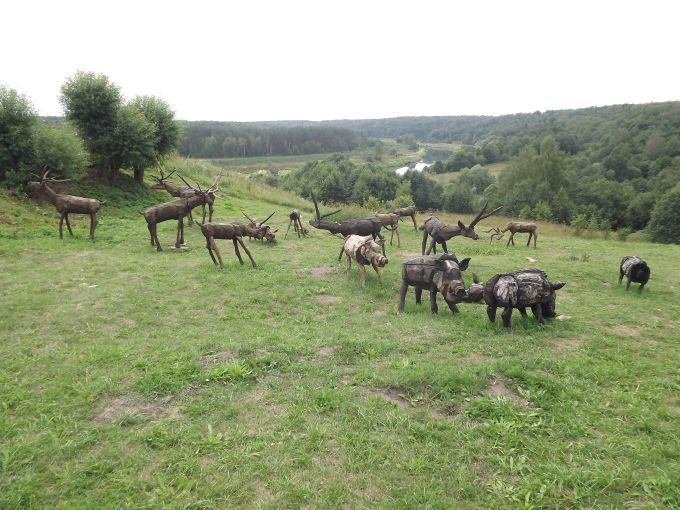
The wooden herd grazing on the high bank of the Ugra River could not be described otherwise than a Peredvizhnik land art picture
What are the genres of contemporary art that the ArchStoyanie Festival is dealing with then? It has been referred to as a festival of “landscape objects” and “landscape architecture”. And yet the loftiest and most fashionable of all labels, ostensibly putting the ArchStoyanie Festival automatically on the world map of contemporary art, is, of course, “land art”. Does the festival fit the definition? It does so only partially. To understand why this is the case, let us turn to the global history of land art and the specific character of its imagery.
The term “land art” (abbreviation of “landscape art”) was introduced in 1969; it was the title of a film by Gerry Schum, shown on German TV. Studies of the creative energy of living nature, video recordings of wise art-dialogues with it – these were the main subjects of the new trend. An equally important role is played by the left-wing idea of overcoming the totalitarian imposition of the concept of the sterile “white cube” art gallery, bringing art out into the open, making it as democratic as possible, liberating it from the dictate of the market and deinstitutionalising it. It is of fundamental importance that all of the great land artists adhered to the principle of site-specific art, which means that the point of departure for them was the idea that the given landscape inside which they created their works was essentially already a complete artistic image; the only thing it might need was a touch of visual staging to enhance its natural brilliance. The specific location and the specific natural material created by the location – these are the two main subjects of classic land art. A perfect example of site-specific art is Walter de Maria”s 1977 “Lightning Field”. The artist chose a huge empty field in New Mexico where 400 steel poles were erected so that their tops created a perfect horizontal line. At sunset and sunrise the steel rods became invisible while the reflected light created the effect of a blazing landscape. During thunderstorms the steel rods attracted lightning and it almost seemed like Zeus himself was racing above the field in his fiery chariot. Another well-known example of site-specific art is, of course, Robert Smithson”s rock and salt crystal spiral-shaped jetty that extends into the Great Salt Lake in Utah. Yet another example: the pink collars with which the artist Christo adorned a group of small islands off the coast of Miami. The resulting Impressionist-style effect prompted Christo to dedicate the project to Claude Monet.
Even when land artists do come back to galleries, what they bring along is the energy of the elements untamed by cultural intervention. The sterile pavilions of art galleries are filled with rocks (Richard Long) or soil (Walter de Maria).
What is essential is that nature is conceived not simply as a beautiful background against which human ambitions are realised but rather as a full-fledged co-author of the artistic message. It is not a coincidence that the term “heterotopia”, borrowed by Michel Foucault from the area of biology, comes up so often when land art is discussed. In the context of culture, it acquires the meaning of “another place”, a topsy-turvy version of the traditional art topography; a place that has emerged suddenly, unexpectedly become an art territory and made an equally “sudden” exit.
Who among the Russian artists can genuinely claim to be a land artist? Probably no-one. However, there are certain projects that would indeed fit the description of the genre. It definitely would not be out of place to make a mention of Alexander Ponomarev who made a whole island in the Barents Sea disappear thanks to clever use of a smoke screen – or perhaps Francisco Infante and Nonna Goryunova who introduced a system of modules and mirrors into the landscape to create the effect of the nature organically assimilate images borrowed from the early 1900s Russian avant-garde. Or Andrei Monastirsky and the Collective Actions group who parachuted themselves airborne force-style into the Moscow Oblast landscape to grasp individually the laws of the space-time continuum of existence.
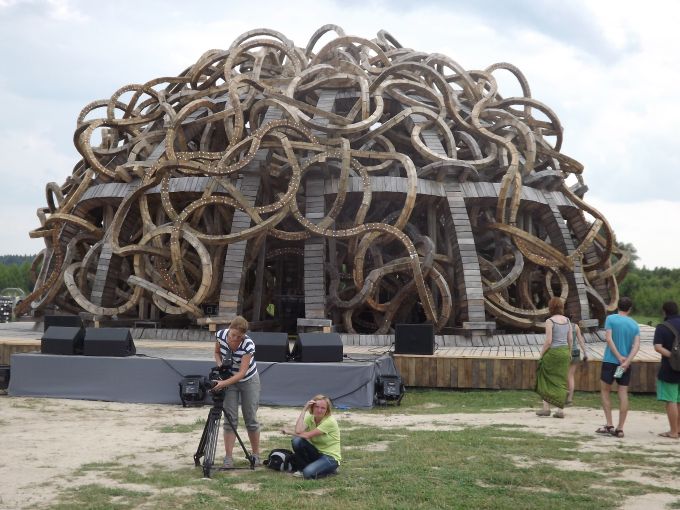
“Universal Mind”, the new object by Nikolai Polissky, is very reminiscent of a dome with brain furrows
Interestingly, it is only indirectly that the artists and architects who work in Nikola-Lenivets, readily described as land artists, are linked with land art – first of all, because nature for them is, as often as not, a context instead of a text; not a full-fledged co-author of artistic activities but a beautiful set that serves as a backdrop against which the artist can solve their own problems.
The most famous, respected and best known artist of Nikola-Lenivets is, of course, none other than Nikolai Polissky. He has been creating wonderfully witty and complex objects in Nikola-Lenivets since 2000 – very much handmade and steeped in gentle irony on universal subjects of global culture, nay – civilisation. He is helped in his work by farmers from the neighbouring villages who can now proudly call themselves artists thanks to Polissky. The wicker tower of “Lighthouse” and hyperboloid coolong tower; the “Large Hadron Collider”, comprised of smooth wooden logs; the “Border of the Empire” triumphal obelisks as well as “Universal Mind”, this summer’s premiere – all these amazing objects are truly redrawing the boundaries of land art as we know it. What makes them so particular is that they translate the theme of heterotopia as an unexpected yet quite real place into a subject of utopia, literally – “no place”, a place that does not exist. A popular quote from Russian folklore – “go I know not whither and fetch I know not what” – could well serve as a motto to these works and the landscape here becomes a kind of a frame to the fairy-tale topos. Polissky explores the archetypes of the national consciousness, pays tribute to myths of Russian avant-garde and keeps in touch with the latest achievements of the natural sciences. Each subject, be it the “hadron collider” or the firebird, is arranged as a deliberately irreal monument to the human imagination – fantasy. In other words, what Polissky’s opuses are actually dealing with is not nature and landscape; it is humanity, archaic beliefs and the collective unconscious of the civilisation.
This is a typically Russian correction to the land art subject, defined by our logocentric thinking and desire to feel at home in the realm of dreams, fantasy and legend instead of reality. The art of the “Polissky artel” serves as another reminder that two of the fundamentally important characters in Russian culture are still Oblomov and Manilov.
Surprisingly enough, instead of rejecting this utopian folkloristic discourse, the young generation of architects and artists who mount the ArchStoyanie Festival have actually adopted it as an axiom, adjusting it to their own preferences. Year after year, curators of the festival, the young architects Anton Kochurkin and Yulia Bichkova devote themselves to creating fairytale topoi existing only in their imagination, erecting them in the huge fields adjacent to the village of Nikola-Lenivets. The “Border” is followed by other topics: after “Noah”s Ark” comes “Outside the Land”, then the “Shed” which takes on the form of a folklore-inspired “hut on a chicken’s leg”, jam-packed with all sorts of wonders. This year’s theme was navigating the land of utopia; the festival was given the title of “Signs of Movement”.
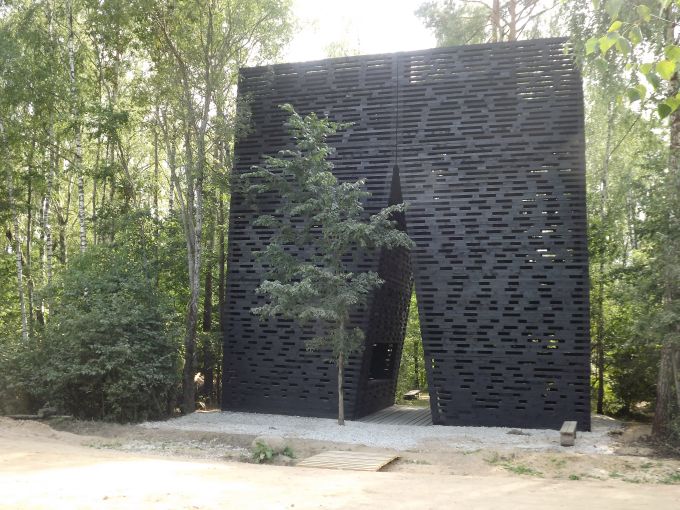
The monumental arch by Boris Bernaskoni could be considered the apotheosis of this year’s ArchStoyanie Festival
Of course, the best objects featured at these festivals are not modelled on land art; rather, they are inspired by the language of generous visual fantasies – the language of the theatre, of set design. A perfect cylindrical rotonda (by architect Alexander Brodsky) appears in the middle of an empty field: it could have been taken out of a Renaissance perspective painting. A procession of fantastic rafts, built by masters from different countries, is floating down the Ugra River. The perforated walls of a shed give us an illusion of the eternal starry sky (a project by the Meganom architectural firm). This year the architectural bureau of Boris Bernaskoni erected a giant triumphal arch on the border between the forest and an empty field. The sculpturesque arch is incredibly beautiful; the walls contain thousands of small traps for sunlight. The roof accommodates a viewing platform and even a country-style water well. The arch, intriguingly reminiscent of the perspective scenery by Palladio and Serlio, marks the axis of the “signs of movement”. The scenographic féerie of the utopia: that is our original answer to the global trends of site-specific art and land art.
Typically, the international artists and architects invited by the curators are much more consistent in staying true to the subject of “landscape architecture”. For instance, the French architects from Atelier 710, working at ArchStoyanie since 2009, have done a very real job tackling an impenetrable brushwood opposite the village of Nikola-Lenivets. They removed the scraggy trees that blocked the light; gave a more regular shape to the crowns of the remaining ones; cleared the field and sowed it with buckwheat with its gentle white blossoms; built little footpaths and squares. In other words, they created a rationally planned space for displaying objects of art. They named the new park “Versailles” and come back every year to carry on with the work.
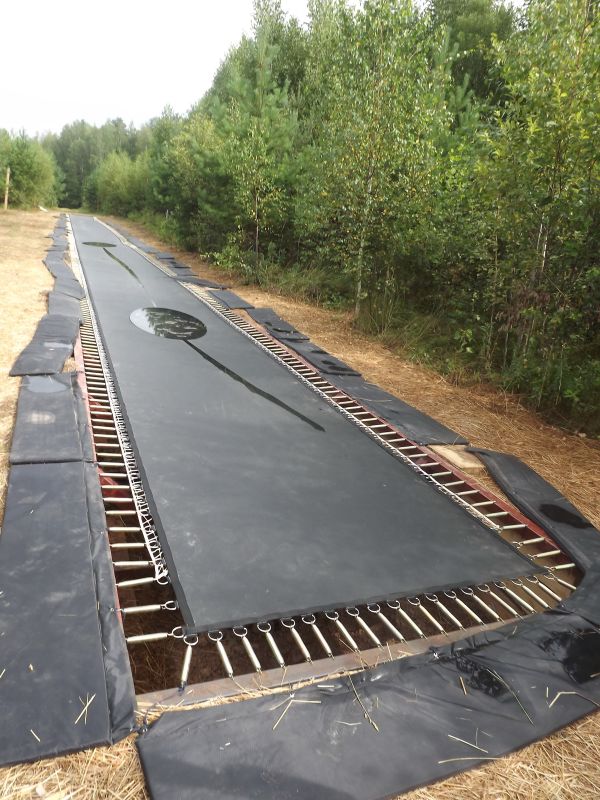
The rubber track running away into the perspective of the land art is a minimalist masterpiece by the Estonians from SALTO Architects
This season has brought another project that sticks to the genre of land art: the “Fast Track” installation by the Estonian architects from the SALTO Architects group. A trampoline-like strip of rubber fabric is stretched above a wide ditch, measuring over 50 metres in length; you can jump on it, run or leap along it. The rubber track integrated into a living landscape looks completely surreal. Running down the track brings so much more than pure childish happiness: it also gives occasion to consider the multi-dimensionality of the speed coordinates existing in the natural world. Neither “Versailles” by Atelier 710, nor the “Fast Track” by SALTO Architects are in any way incorporated into the usual narrative or connected with any specifically historical subjects. Nature is on equal grounds with culture here.
Is it a good thing or a bad thing then that, to paraphrase the well-known poem by Yevtushenko, “land art in Russia is more than just land art”? The peculiarities of existence of this contemporary art movement in Russia confirms our ageless love for clear images that are easily traced back to recognisable visual or literary contexts. It confirms our distrust for pure abstraction. I believe there is no prejudice in saying this: it is a given best accepted as such. Why not surrender to the pleasurable excitement of watching the endless battle of the foreign heterotopia with our native utopia in the territory of landscape art?